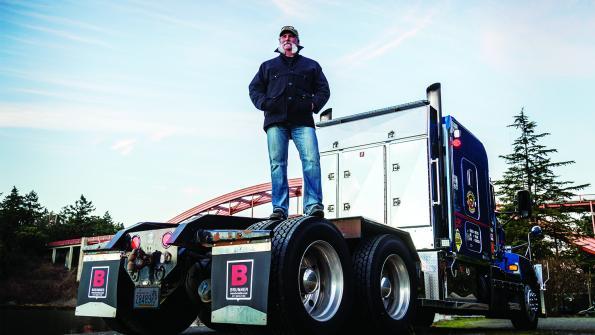Photo: C.J. Ruxton Photography
Cristina Commendatore, Fleet Owner / Marc Springer tried to promote a positive image of the trucking industry while starring on A&E’s Shipping Wars. /
Remember when movies like Smokey and the Bandit and Convoy were at the height of pop culture back in the ’70s? Truck drivers were depicted as road warriors and modern-day cowboys—heroes even.
A lot has changed in four-plus decades. Technology has taken on a much larger role in the industry, and the industry as a whole is more heavily regulated and held more accountable than ever before.
But Jim Gardner, vice president of marketing at Omnitracs, says he believes that romantic image of the driver still exists and notes that media-driven perceptions of the industry have never been accurate.
“There are well-worn media clichés seen in movies and television regularly, and while they don’t serve to enhance or change perceptions of the industry, their damage is likely nominal,” Gardner explains. “Where I get resentful is when personal injury attorneys suit up for commercials on the roofs of tractor-trailers to talk about the supposed dangers of commercial trucks. It is opportunistic and misleading, especially when multiple studies show that well over three-quarters of accidents involving commercial trucks are the fault of the passenger vehicle.”
In an effort to have some fun while recognizing the value commercial truckers bring to our economy, Omnitracs developed a web-based video game that makes users think: What would happen if trucks stopped rolling? For starters, it could look a lot like the zombie apocalypses we’ve seen on TV and in today’s movies.
For Omnitracs, which provides fleet management solutions to transportation and logistics companies, the message is clear: “If trucks stopped rolling, in just 24 hours, gas prices would skyrocket and hospitals would exhaust basic supplies. In two to three days, supplies of bottled water and nonperishable goods would be exhausted. By the end of the week, hospitals would run out of critical supplies of oxygen and medicine.”
The game, Zombie Dispatch, takes place in the immediate aftermath of a zombie outbreak. The hero of the game is Dan, a truck driver trying to deliver a cure to the hospital.
Players navigate Dan’s truck through rural and urban settings, dodging debris and damaged vehicles while eliminating the waves of zombies running down the road. The game paints Dan as a hero and touches on a serious industry concern: the driver shortage. It explains there aren’t as many drivers on the road as there were a few years ago.
“The daily responsibilities of a driver are underappreciated and often unrecognized, and even more so in emergencies when their job is most difficult and most in demand,” Gardner tells Fleet Owner. “Acknowledging first responders, troops, doctors and nurses, is all very well-deserved, yet well-worn territory. The Omnitracs view is that drivers deserve similar recognition for their contribution to our comfort, security, and standard of living as well as when helping provide relief and to rebuild after an emergency.”
Roger Snider is a professional photographer who has been shooting trucks for the past decade, and he, too, has been working to maintain that romantic image of the industry that Gardner discusses.
Snider is working on a coffee table book, Ultra Rigs of the World, about truck culture worldwide. Through his travels, Snider has learned that people in other countries view America as the mecca of the custom-truck world. Snider also puts together a calendar every year called Chrome and Elegance, which features custom-designed trucks accessorized by beautiful landscapes, elegant women, or the drivers themselves.
“My goal is to make the most memorable pictures of trucks so 30 years from now people say, ‘That guy really captured the spirit of the truck, and he really put it in a cool landscape,’” Snider says. “The goal is to make images like they did 20-30 years ago.”
More than a decade ago, when social media wasn’t what it is now, Snider says the big deal was getting published in a magazine. Now, with Facebook groups, Snapchat stories, and Instagram feeds, Snider finds that teenage and millennial fans are curating and sharing his photos.
Snider says he’s always been fascinated with trucks, and since he was a kid, he was convinced he’d be a truck driver one day. Ten years ago, Snider met a documentary film director on a plane who created a film on long-haul truck drivers. The director ended up asking Snider to see his portfolio and eventually asked him to take some public relations images of trucks and drivers.
For the project, Snider went to a convention in Las Vegas to begin shooting. He was instantly hooked.
“They looked like big toys to me, and it played with my childhood psyche,” he explains. “And these real trucks looked cooler than what I played with as a kid. It was my goal to meet these people and befriend them. I wanted to be the guy who goes to these cool places and shoots the truck images.”
So that’s exactly what he did.
One of Snider’s portfolios, Man and His Big Rig, illustrates the truck and its owner as functioning works of art. He portrays the truck as a work of art, and also as a practical, operational tool used to get a job done, while the owner is the sculptor who created it.
“I would hope this would put the industry in a positive light that someone has pride enough in their truck to build it and maintain it,” Snider says. “It goes back to 30 years ago when people took their jobs seriously and had a pressed shirt and nice jeans and boots, and people had self-respect.”
Trucking in reality TV
One of those drivers who holds the industry in the highest regard is Marc Springer, and he’s been able to share his love of his profession with the world.
Springer, who has never really been one for staying put, is a 59-year-old owner-operator who has been on his own since he was 14. He pursued a professional hockey career as a young man, went on to work for a state Teamster union driving trucks, ended up selling Harley-Davidsons until the 2008 Recession, started his own trucking company, and then made his reality TV debut.
If Springer’s name sounds familiar, it’s because he was on A&E’s Shipping Wars. He’s the guy with the white handlebar mustache, the one who tells it like it is, and he drives the now recognizable royal blue T600 Kenworth.
Springer was working as an independent owner-operator, filling the empty space on his truck via uShip, an online transportation marketplace connecting shippers and carriers, when he got an email from uShip asking him if he wanted to be on A&E’s new reality show.
The show, which began airing in January 2012, followed independent carriers competing to make the most profit hauling unique loads.
Springer initially thought it was a joke. “I considered deleting the email, but instead wrote a smartass email back,” he says with a laugh. “And they said, ‘Well, this guy’s perfect.’
“I thought it was a neat opportunity,” Springer adds. “I would run my business and they’d film this show.”
What he didn’t anticipate was that reality TV and the operational nature of the trucking business don’t exactly go hand in hand. Daily trucking operations require efficiency, safety, and putting the customers’ needs first, Springer explains. But he found working efficiently is nearly impossible when multiple takes and scenes are needed for editing and production.
“I enjoyed the experience. It was stressful at times,” Springer notes. “It was hard to operate my vehicle with a film crew in the truck. It didn’t fall in line with how I wanted to run my truck and my business, but I signed up to do it.”
“To me, it was important for the other drivers in the industry to understand I was a driver and I was a professional and I cared about my customers and doing a good job,” adds Springer, who ended up filming all 100 episodes with the show. “I’m not going to portray the trucking industry as anything other than what I believe it to be: a super professional, important part of our country. And I wanted that to come through.”
Overall, Springer says he feels the show portrayed the industry in a positive light and opened people’s eyes to uShip. Next time, though, Springer says he wants to focus on something that depicts a more honest view of trucking.
Growing up in the industry
Unlike Springer, whose nomadic, entrepreneurial nature led him to trucking, Craig Fuller has been around the industry his entire life. His family runs U.S. Xpress, and he is the managing director of TransVix, a transportation futures contracts marketplace where shippers, carriers and brokers can buy and sell standardized futures contracts on spot trucking.
In today’s culture, Fuller says he feels there is a lot of intimidation around trucks. He’s been in cars with people who complain about heavy trucks. He regularly sees attorneys’ ads that portray trucks as dangerous. He often encounters sensationalized stories from the mainstream media about truck crashes and how dangerous tractor-trailers are.
“That just compounds the industry,” Fuller says. “The industry can’t do well to defend itself. It’s not a respected industry by any means, and that’s a problem.”
Another major problem, according to Fuller, is the industry has a tough time appealing to millennials as a viable career. Millennials have grown up in an age where they can easily acquire a student loan from the government, and since mainstream culture touts the importance of having a college degree, traditional blue-collar work has become less appealing.
Fuller adds that the legacy of the traditional truck driver—a Southern, blue-collar white guy—is a thing of the past. He stresses the importance of the industry reaching out to other demographics—Hispanics, migrants, minorities, and women—who see truck driving as a lucrative job compared to alternatives.
What Fuller has noticed is that the industry is getting better at embracing social media and other technologies that help the life of the driver, but, he says, the industry as a whole still falls short.
“I think young people have an opportunity to connect with people regardless of where they’re located, and I think trucking should embrace that social aspect,” he adds.
U.S. Xpress and other carriers do use social media to build a sense of community, which Fuller says works as a good outlet to reach drivers and help them stay connected and maintain their lifestyles. He does warn that companies should steer clear of posting only about themselves, as it could end up deterring younger drivers from applying for jobs.
“Millennials are investing more in lifestyles than in products,” Fuller notes. “I think trucking companies could think of more things like time off and more promises toward trips to attract millennials.”
So whether it’s making trucking more attractive to millennials or bringing back that romantic image of the trucker as a lone cowboy or cowgirl in pop culture, the industry still struggles to overcome the stigmas attached to it. But many, through their work, have spoken up to say that trucking and its drivers are essential to keep our economy moving.
View original article

